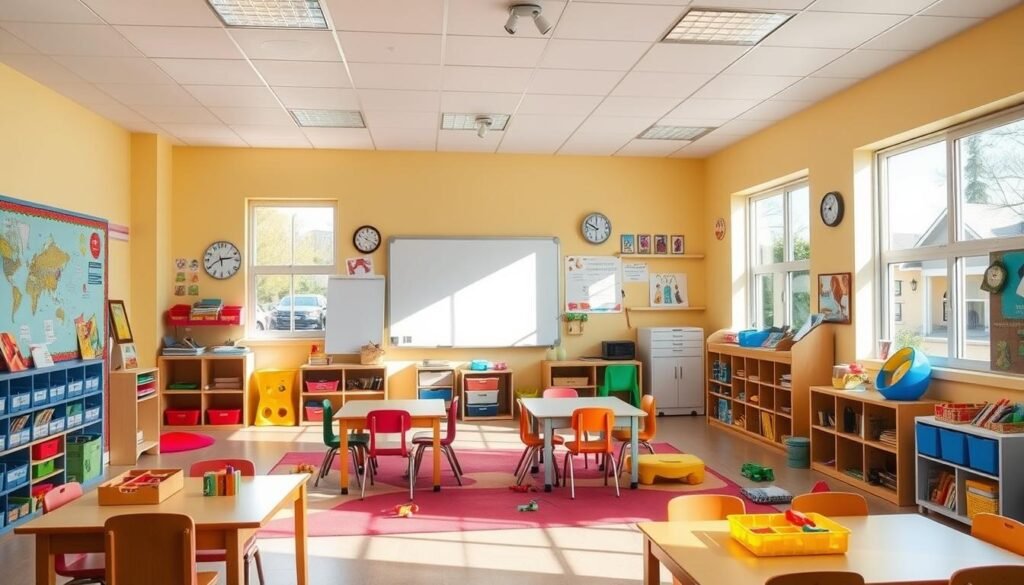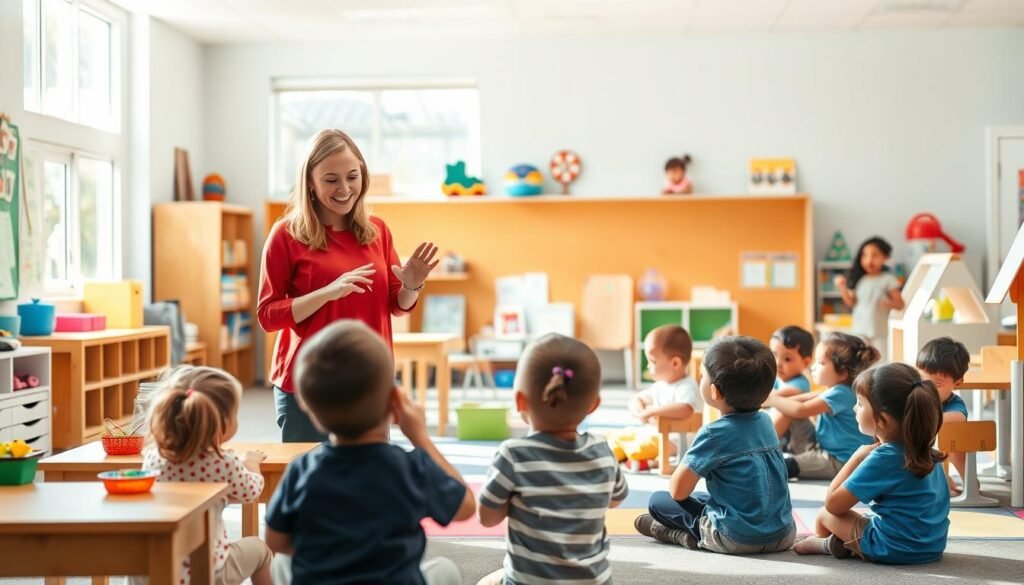
Managing a kindergarten classroom needs careful planning and a deep understanding of early childhood education. Your classroom management style greatly affects young learners’ growth. With about 28 students aged 5-6 in each class, it’s key to create a well-organized and supportive space for learning.
Studies show that good classroom management can boost student cooperation by 40% and their engagement in learning. By using structured methods, you can turn a chaotic classroom into a place where young minds grow and develop.
Creating a responsive and dynamic kindergarten classroom is crucial for early childhood education. It requires careful planning, consistent routines, and teaching methods that keep students interested and motivated.
Table of Contents
Understanding Behavior as Communication in Early Education
In kindergarten classrooms, behavior is more than just actions. It’s a complex language children use to express their emotions and needs. Understanding this communication is crucial for effective child development and teaching strategies.
Research shows that 500+ educators identify addressing challenging behavior as their top training need. With preschool expulsion rates three times higher than K-12 settings, teachers must develop nuanced approaches to interpreting young learners’ behaviors.
Recognizing Behavioral Patterns
Children exhibit behaviors through different temperament types:
- Easy-going children: Adaptable and generally happy
- Slow-to-warm children: Sensitive and require more adjustment time
- Active children: Intense physical and emotional reactions
Implementing Problem-Solving Approaches
The Pyramid Model offers a multi-tiered system for managing classroom behaviors. Key strategies include:
- Establishing clear classroom rules
- Building positive relationships
- Promoting student engagement
Supporting Emotional Development
Emotional self-regulation is critical. Studies show that a child’s self-regulation skills at age four can predict math and reading achievement through second grade. By understanding emotions and providing supportive environments, educators can help children develop essential social-emotional skills.
Consistent routines and clear visual schedules can significantly reduce challenging behaviors in early childhood settings.
Essential Components of Kindergarten Classroom Management
Creating a great kindergarten classroom needs careful planning and thoughtful ideas. Classroom management is more than just making rules. It’s about making a place where young students can grow and learn well.
Important parts of good classroom management include:
- Setting clear expectations from the start
- Creating a structured yet flexible learning space
- Developing consistent daily routines
- Using positive reinforcement techniques
Studies show that clear classroom rules can make students feel more responsible by up to 30%. Visual aids are key in helping young learners understand what’s expected. Posting classroom rules where children can easily see them helps reduce rule violations by 30%.
A well-managed kindergarten classroom is a foundation for future academic success.
How teachers talk is also very important in classroom management. The way you communicate sets the mood for the whole learning space. Giving immediate positive feedback for good behavior can increase student motivation by 20% and encourage the right actions.
When designing your kindergarten classroom, think about these smart strategies:
- Create designated learning centers
- Use color-coded organization systems
- Implement predictable transition routines
- Develop age-appropriate behavioral expectations
Remember, simplicity is key in kindergarten classroom management. Young learners do best with clear, consistent, and positive guidance. This makes them feel safe and supported in their learning journey.
Building Strong Teacher-Student Relationships
In early childhood education, it’s key to build strong bonds between teachers and students. Trust, communication, and emotional safety are the base of a good classroom.
Creating these bonds takes effort and consistency. Studies show that good teacher-student relationships help students do well in school and socially.
Creating Trust Through Daily Interactions
Trust grows from small, meaningful moments. Your daily actions can change the classroom:
- Greet each student personally by name
- Show genuine interest in students’ lives
- Practice active listening during group activities
- Demonstrate consistent and fair treatment
Fostering Positive Communication
Good communication is key in building relationships in early childhood education. Use positive words and let students share their thoughts.
When students feel heard, they become more engaged and motivated to learn.
Establishing Emotional Safety
A supportive classroom makes students feel safe and valued. Use teaching strategies that focus on emotional well-being:
- Validate students’ feelings
- Model respectful interactions
- Provide consistent emotional support
- Encourage peer collaboration
Remember, strong teacher-student relationships take time. They grow from consistent, genuine interactions that show care and respect.
Setting Up an Effective Kindergarten Classroom
Creating a great kindergarten classroom is more than just decorating. Studies show that a well-designed classroom can boost student engagement by up to 30%. Your classroom’s layout is key for learning through play and effective teaching.
Here are some important tips for organizing your kindergarten classroom:
- Create distinct learning zones for different activities
- Add sensory materials all over the space
- Use flexible seating arrangements
- Make sure there are clear boundaries between areas
Having different learning areas can make a big difference. Research shows that classrooms with zones can cut down transition times by about 20%. For example, a cozy reading corner can make kids more interested in reading, improving literacy by 25%.
Sensory materials are very important in early learning. Using touch-friendly surfaces, textured objects, and interactive stations helps kids learn. Tactile experiences are key to learning through play.
A well-designed kindergarten classroom is a dynamic learning ecosystem that adapts to children’s developmental needs.
Think about adding natural elements and balanced colors to reduce too much stimulation. Studies say classrooms with calm colors can help students focus better by up to 20%. Adding personal touches that show student work and interests can make them feel more at home by 30%.
Developing Consistent Daily Routines and Procedures
Creating predictable preschool activities is key to good classroom management. Routines give young learners a sense of security. They know what to expect all day. This helps avoid disruptions and makes learning smooth.
Good classroom management means structured approaches. This makes kids feel confident and engaged. Studies show that consistent routines boost student behavior and learning.
Morning Meeting Structures
A good morning meeting sets the day’s tone. Here are some strategies to try:
- Create a welcoming greeting ritual
- Use visual schedules to outline the day’s activities
- Incorporate movement and interactive activities
- Practice social-emotional learning skills
Transition Time Management
Smooth transitions are vital in preschool. Here’s how to manage classroom movement well:
- Use visual timers to signal transition periods
- Develop consistent hand signals for quiet transitions
- Practice transition routines regularly
- Provide clear, simple instructions
End-of-Day Procedures
Ending the day with a routine helps students reflect and prepare for tomorrow. Effective end-of-day procedures can reduce anxiety and create a sense of closure.
Predictability is the key to successful classroom management in early education.
By using these strategies, you’ll create a supportive learning environment. Young students will feel secure, engaged, and ready to learn.
Proactive Teaching Strategies for Early Learners

In early childhood education, using proactive teaching strategies is key. It helps make learning fun and safe. How you manage a kindergarten classroom affects students’ feelings and learning.
Good teaching means knowing and meeting students’ needs. Studies show that talking to students often makes them feel safer and more engaged.
- Implement predictable daily routines
- Use visual aids to communicate expectations
- Create a calm, structured learning space
- Practice mindful communication techniques
Teaching kids about managing their feelings is very important. By using feeling brainstorms, you help them learn new words for their feelings. This also helps them learn to control their emotions better.
Understanding emotions is the first step to managing them effectively.
Adding mindfulness to your teaching can change your classroom. Simple things like breathing exercises and calm movements help kids focus and feel their feelings better.
- Practice breathing techniques
- Use calming sounds during transitions
- Encourage artistic expression
- Implement short meditation moments
Your main goal is to make a place where young learners feel safe and understood. You want them to be able to handle their feelings and learn well.
Creating a Positive Learning Environment
Making a lively classroom is key for kids to learn and grow. Your kindergarten space can really help students get excited about learning.
A good learning space changes how kids see school. Studies show that supportive classrooms can make students 20% more motivated. They also do better in school.
Implementing Reward Systems
Good reward systems help kids stay motivated. Here are some ideas:
- Create visual progress trackers
- Use sticker charts for positive behaviors
- Offer age-appropriate recognition badges
- Develop classroom “achievement walls”
Celebrating Student Success
When we celebrate what students do well, it builds a strong classroom family. Kids who get positive feedback do 30% better in school.
- Conduct weekly success sharing circles
- Display student work prominently
- Create special “star student” moments
Managing Classroom Energy
Keeping the classroom energy right is important. Learning through play helps keep kids engaged.
Dynamic classrooms promote active learning and student participation.
Use movement breaks and calming activities. Keep the room between 68-74°F to help students focus and feel good.
Addressing Challenging Behaviors Effectively

Dealing with tough behaviors in kindergarten needs care and understanding. Every action a child makes is a way to communicate. This helps teachers meet their needs better.
Here are some important strategies for handling tough behaviors:
- Spot early signs of behavioral issues
- Use positive rewards
- Keep classroom rules consistent
- Make plans tailored to each child
Studies reveal that about 30% of young kids worry parents and teachers. Their brains are still growing, affecting how they feel and act.
Good classroom management means having more positive interactions than corrections. Using pictures can help kids know what to do and feel less stressed during changes.
Prevention is key, including:
- Being clear about what’s expected
- Warning kids before changes
- Letting them choose
- Teaching them to calm down
Working with parents is crucial for helping kids emotionally. Keeping in touch with parents helps everyone support positive behavior.
The aim is not to stop tough behaviors but to teach kids to handle their feelings and learn important social skills.
By using these methods, teachers can make a safe space for kids to grow and behave well.
Integrating Social-Emotional Learning and Literacy Skills
Learning to read and write is more than just knowing the ABCs. Social-emotional learning (SEL) is key in early education. It helps students grow emotionally while they learn.
Nursery rhymes are great for teaching both reading and feelings. Poems like “Jack and Jill” teach kids about themselves and others. Reading together helps kids learn to control their emotions and connect with others.
Learning to write and read also improves fine motor skills. Kids learn to express themselves through words and actions. Studies show SEL helps kids read 20% better, showing how emotions and learning are linked.
Teachers can make learning fun by mixing reading with emotional learning. This way, kids grow in all areas. They do better in school and learn to manage their feelings.
